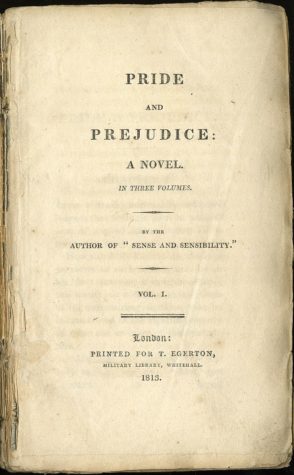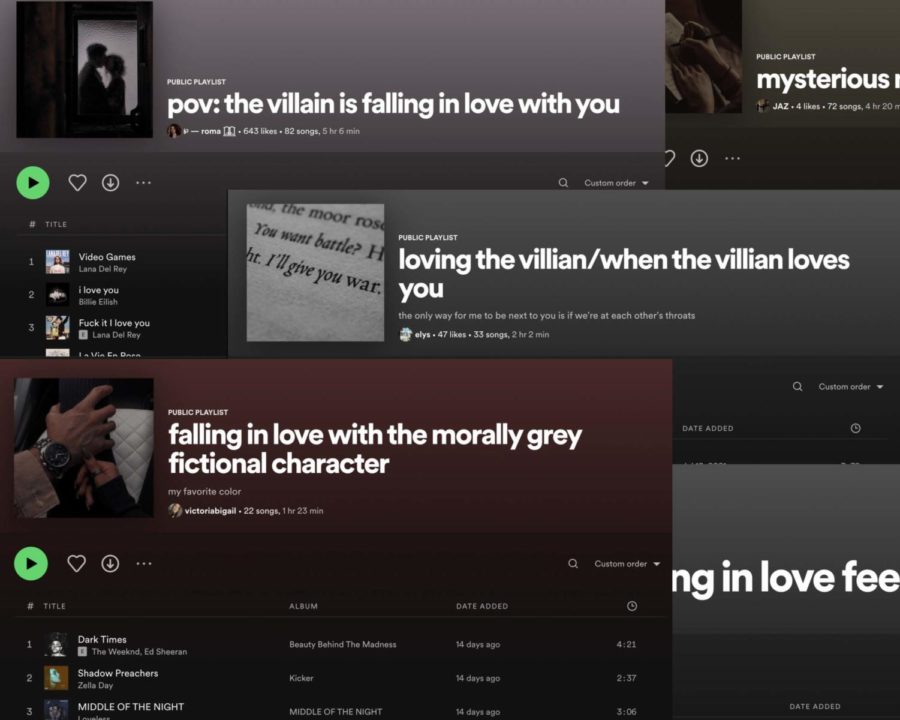Burn Down the World For You: The Appeal of the Morally Gray Character
Throughout history, morally gray and mysterious characters prove, time and time again, to be some of the most popular characters amongst fans. This begs the question: Why?
Here is a collection of Spotify playlists depicting the appeal for characters other than the typical “good person.”
“In vain I have struggled. It will not do. My feelings will not be repressed. You must allow me to tell you how ardently I admire and love you.”
It was a crisp, late January morning of 1813. The snow had settled on the grass, its shine resplendent against the sun. But what many did not know as they awoke, was how a certain, game-changing book had been put on shelves for the first time.
Jane Austen was 36 years old when she published Pride and Prejudice anonymously, with Mr. Darcy’s monologue being a large part of the literary masterpiece. His relationship with the protagonist Elizabeth begins with biting, snarky dialogue, ultimately leading the characters to fall in love with one another. Jane Austen’s book is one of the first of many readily available books with the phenomena of the mysterious, occasionally morally gray character.
But first: what really is a morally gray character?
A morally gray character is essentially a character who operates outside the norms of “good” and “evil.” For example, they may injure others, while also donating to children’s hospitals. Authors usually write in a morally gray character to either make the readers pause and dwell over them or to spark an internal conflict within the protagonist. Their fanbases have grown over time, consisting largely of teenage girls over popular social media platforms such as Tumblr and TikTok.
Their appeal may start at where their priorities lie. After all, many of these characters promise universes where they would end the world a million times over for their love interest.

While there is a distinction between mysterious and morally gray, it’s worth noting that many instances containing these usually end with the line being blurred between the two. Some instances include Edward Cullen, Batman, Kaz Brekker, Veronica Sawyer, and more. Edward, one of the love interests of the bestselling series Twilight, was someone whose mysterious magnetism helped prompt the protagonist, Bella, to fall in love with him. He loved Bella in a way that the author intended to depict as dangerous and tempting at the same time. After all, he might have been a vampire but he was willing to fight that for her. This idea of having someone who loves you enough to set the world aflame is something very appealing for many and contributes heavily to part of the reason why Twilight remains as such a cult classic today.
To delve deeper into why exactly this phenomena is very prominent today, I asked twenty six high school students from Bronx Science about their opinions on how likely they would be to favor the mysterious or morally gray character. They voted on a scale of one through ten, with one being the lowest and ten the highest. The majority of the voters voted eight and nine out of ten. In second place came seven out of ten. These statistics point to the possibility that a lot of students are more likely to love the morally gray and mysterious characters in media as opposed to other characters, even if they aren’t meant to be loved this way.
But that still begs the question: why?
To help answer this, I turned to TikTok. At the point of this article being written, there are over 250 million views on the #morallygrey hashtag. In addition, there are over 6.2 billion views on the #villain hashtag. Finally, there are more than 4.5 billion views on the #enemiestolovers hashtag.
Enemies to lovers. The phrase alone suggests conflict, drama, and maybe even some broodiness. In fact, half of the students whom I interviewed indicated that they preferred enemies to lovers over other romance tropes. While I was conducting research for this article, I decided to give the hashtag a try. Maybe, just maybe, I would find something in its nooks and crannies that would somehow connect to this phenomenon. The more I fell into the rabbit hole, the more that I realized a pattern. In the midst of colorful photos of swords and dragons, and sweeping, dramatic music reverberating off my AirPods, most of the videos made “him” the villain and “her” the soft-spoken protagonist.
This made me pause. These videos got thousands of views and just as many likes, suggesting that there was an appeal for them. And yet, I scrolled on and on, just to see the same formula over and over again flashing across my dull screen. “She was sunshine, and he was midnight rain,” sang a user, as Taylor Swift’s Midnight Rain belted in the background.
As I ventured further into the depths of TikTok, it became ever increasingly clear to me that a morally gray and mysterious character is often depicted as a white man. Media, even internationally, is much more likely to feature white men more prominently than other people. This most likely is because of certain prejudices that date back centuries. This is a problem in the entertainment industry, and it connects to our world as a whole. In the end, humans can be morally gray and mysterious; not just a specific type of them. This includes women, people of color, and everyone in between. Even though fictional characters are ultimately fictional, the ideas they reflect and the themes they embody certainly have real effects on society, however out-of-the-world they may be. In situations like these, where this one group overwhelmingly overrules this particular branch of fictional characters, it’s clear that something must change. Fictional characters may be fictional, but they shouldn’t limit people to certain roles and not allow them to fill others because of things such as race or gender. This doesn’t mean that someone has to dislike these characters because of prejudice’s influence on them, but it does mean that we should be aware of it.
Morally gray and mysterious characters are multifaceted. This may contribute to their appeal as they operate in shades of gray, making them unpredictable and interesting because of it. While talking about Wanda Maximoff from the Marvel Cinematic Universe, Maya Jowata ’25 said, “I personally don’t fall for fictional characters, but in terms of nuanced characters that are morally gray I really like Wanda because she has a very interesting backstory.” The complexity of these characters, as Jowata points to, and how they got to where they are, pull a reader in. The mysterious, nearly villainous characters usually have a reason for why they are as they are, reasons which can be touched upon less in other happy, upbeat characters. Sometimes, this character does end up doing unspeakable things, which can so often be romanticized by the fandom because of their backstory. But sometimes, they end up being the “hero” of the story, their actions justified and right. In the end, it was the person who never was vulnerable enough to share their true emotions with the world that ended up saving it.
Another possible reason for their appeal is how they, simply put, seem lonely. As the blog Me & Ink notes, “Morally gray characters can often be on their own with limited people helping or sympathizing with them. I think when we see an absence of love, we naturally try our best to fill it and the love takes over.” This feeling of pity for a character, and the pull to somehow tell them that they’re not as alone or hopeless as they’re depicted, can sometimes be strong enough that many turn into fans. On the fanfiction side AO3, there are over 14,000 works under the tag “Everyone Needs A Hug.” People want to tell these characters that they are loved, even if they are fictional, suggesting that this could be a testament to human empathy.
These characters, in the end, are widely popular, regardless of whether they are meant to be loved or not. #Darklina, the ship name between the antagonist and protagonist of the bestselling book series Shadow and Bone, has over 110 million views on TikTok. This is echoed in the multitude of fanfictions and social media posts for Batman, Aaron Warner, Rhysand, and Levi from Attack on Titan to name a few. They’re complex, and somehow will always have this indescribable pull to them that causes them to have such a large fandom.
If they hate the world for its ugliness, but they love you despite it, wouldn’t that be a mess?
And perhaps it is a mess. Perhaps, beyond all the “Villain x reader”s and the “POV: Draco makes eye contact,” it’s just the wonder of the millions of people who make up fandoms reaching into the void for some semblance of comfort in characters who couldn’t care less. But maybe there is some comfort in believing that you can be the exception. In finding a community just like you, people who might just be here for fun, or people who are here because they’ve convinced themselves that Anakin Skywalker would definitely fall for them. When Jane Austen put her pen to paper in the 19th century, she probably never dreamed that her character of Mr. Darcy would still be popular today through his mysterious allure. Her work is truly a testament to this phenomena. Because even if these characters don’t show the full extent of their personality to the world, you can believe that they still love you.
And maybe that’s beautiful too.
While talking about Wanda Maximoff from the Marvel Cinematic Universe, Maya Jowata ’25 said, “I personally don’t fall for fictional characters, but in terms of nuanced characters that are morally gray I really like Wanda because she has a very interesting backstory.”
Krisha Soni is an Editor-in-Chief for ‘The Science Survey.' She loves storytelling and journalistic pieces that bring their subject matter to life; in...

